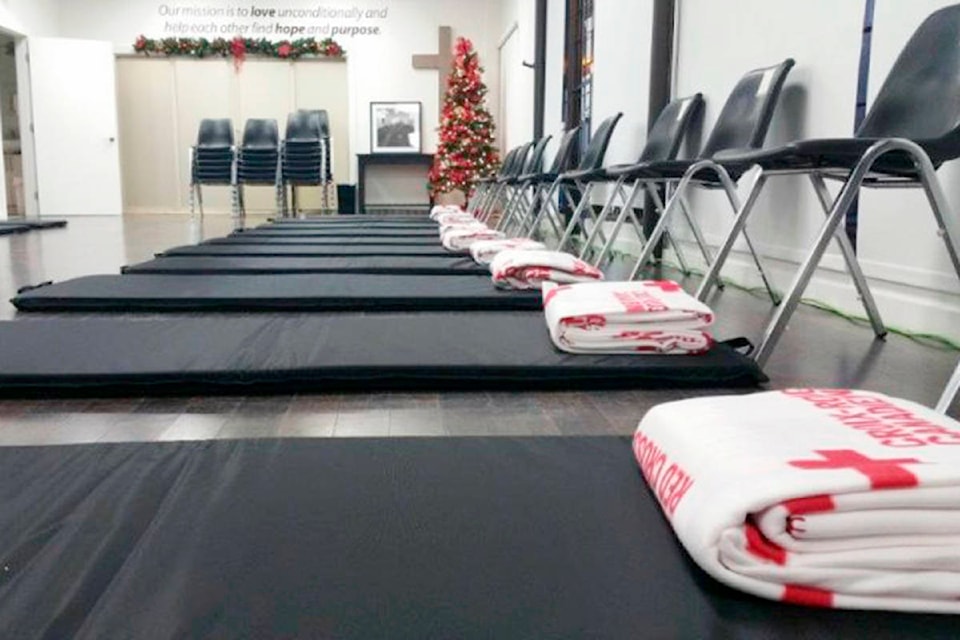“I have ulcers,” said Surrey’s Extreme Weather Response co-ordinator as rain pelted the dark and dreary city Monday afternoon.
The night prior, emergency beds for the homeless were called to open for the first time this season in Surrey and White Rock.
Jonquil Hallgate took a deep breath as she revealed there are very few spots in the city’s north end this year.
“We have pretty much no spaces in North Surrey,” Hallgate said. “We’re waiting for FRAFCA (Fraser Region Aboriginal Friendship Centre Association) to come online with 18 spaces, but it’s not quite ready. We, at this point, don’t have many other spaces. We have 10 spaces for youth with Pacific Community Resource Society and 10 spaces for women at Nightshift (Street Ministries in Whalley). But that’s it.”
The problem, said Hallgate, is many of the former locations for extreme weather shelters have become temporary or permanent spaces, after the closure of 135A Street to tents, meaning those venues are not available for the extreme weather program anymore.
“If one person’s outside and suffering, it’s dreadful,” she lamented.
“When it’s many people outside suffering…” her voice trailing off.
See also: Tents gone from Surrey’s 135A Street, but not all accepted housing: city
See also: Delta’s only emergency weather shelter now open
Currently, there are 25 spots available in White Rock at the Star of the Sea Catholic Church, 25 in Cloverdale at Pacific Community Church, 10 at Pacific Community Resource Society and 10 at Nightshift, for a grand total of 70.
Ideally, Hallgate would like to see that be 130 or 140, and organizers are desparately hunting for sites in the north.
”We need a site in Newton and we need a site in North Surrey. One that can take men and women,” she pleaded. “If anybody knows of an empty space they’re willing to let us have until the end of March, please contact me.”
What spaces are ideal?
“We need to have something that’s a central location, either close to transportation or is easy for people in North Surrey can walk to, and the same in Newton. It should be something in the town centre to allow people to access it easily,” said Hallgate.
“Or if a church, for example, has a gathering room that can accommodate 10 to 30 people, for people on mats, and if we can get in from say anywhere from 7 o’clock to 9 o’clock in the evening and be out by 7 (a.m.) in the morning,” she added, noting extreme weather beds still means people must brave the weather during the day.
Empty storefronts would also work, Hallgate said.
The location would ideally also have a place to store mats and blankets.
Anyone who has space to offer, can email Hallgate at surreyextremeweather@gmail.com.
Also needed are donations for those living on the street, said Hallgate.
Chapstick, cough candies, easy-to-eat snacks, jackets, clean underwear, socks, thin blankets and toiletries such as tooth paste, tooth brushes, deodorant, shampoo and soap are needed. As are toques, mitts, hand warmers, and boots. Contact Hallgate at the email above to arrange drop-off.
See also: Count finds 49 per cent more homeless people in Surrey
See more: More than 100 seniors living on Surrey streets: homeless count
A total of 602 homeless people were identified in Surrey in the most recent 2017 Metro Vancouver Homeless Count, done every three years.
That was a 49 per cent increase (199 more people) than were counted in Surrey in 2014, the last time the count occurred.
But, as Hallgate has often stressed, “the count doesn’t give us the number we believe is the reality.”
Last June, an estimated 160 homeless people were moved into temporary Whalley modular units.
But the executive director of Lookout Housing and Health Society, which runs the temporary housing, says there still isn’t enough shelter to meet the demand, despite the new units, which he called a “fantastic start.”
“We’re still turning people away everyday from the shelter (on 135A Street),” Keir Macdonald told the Now-Leader earlier this fall.
What is the Extreme Weather Response program?
The Extreme Weather Response (EWR) program is a provincially funded initiative that officially runs from Nov. 1 to March 31, although in past years, awful weather has resulted in calls to open in October.
This year, the provincial government say it’s providing more than 1,400 temporary shelter spaces and over 750 extreme weather response shelter spaces, in partnership with municipalities and non-profits in approximately 65 communities around B.C.
The beds, often mats on the floor of a building, open “to provide additional temporary emergency shelter spaces during periods of extreme winter weather which threaten the health and safety of individuals experiencing homelessness,” according to BC Housing.
The program is designed to “provide time-limited, weather responsive, temporary shelter spaces in communities where there is not sufficient emergency shelter bed capacity during extreme weather conditions.”
The extreme weather response shelter spaces supplement the almost 2,000 permanent, year-round shelter spaces available throughout the province.
In Surrey, the beds are called to open if temperatures are at or below 0 degrees Celsius, if there if significant snow or rain, or significant windstorms that “may present danger to persons living in wooded areas and/or makeshift shelters.”
Wind, rain and snow weather alerts can also launch an opening.
amy.reid@surreynowleader.com
Like us on Facebook Follow us on Instagram and follow Amy on Twitter
